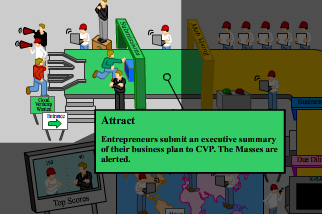In my next two articles, I will talk about pitching for investment money. In this article I will talk about the stages in the pitch process. When pitching to angels through an organized angel group, there is a multi-step process you need to go through. Your end goal is obviously to close a round of financing. However depending on what stage you are at in the process your goals for that step will be different. The best analogy is thinking about the process you go through to apply for a job at a large corporation. So to illustrate, lets walk through the steps for both:
1) Initial application
Job search – you see an ad for a job in an on-line job board or in the paper. You write up a cover letter and a 2 page resume to summarize your experience and why you feel you are a good fit for the job. Somebody in the HR department reads through all the applicants and selects the ones they want to bring in for an interview.
Angel financing – you fill out the angel group’s 2-3 page application for funding. The selection committee evaluates all applications and selects the 3 they want to have present at the group’s next investment meeting.
In either example, your goal is not to get the job or get a cheque. It’s to stand out from the pack and get invited to meet in person. People often find it hard to distill their company & the investment opportunity into such a short application. However, resist the urge to try over complicate things by providing all sorts of detail & information at this stage. Your goal is to look interesting enough to be invited to the next stage where you can provide more information.
2) First interview/pitch
Job search – you meet with the HR resource who tells you about the company, reviews your work experience, asks questions and answers any questions you have. After they interview all selected candidates they determine the short list they will present to the hiring manager to interview.
Angel financing – you pitch your company at the group’s investment meeting to 30-40 angels. You have about 15 minutes to do your pitch and 10 minutes to answer questions from the group. The 10 angels that are interested in your opportunity will sign-up and form a due diligence team to investigate your company further.
Again, in both examples your goal is not to get the job or cheque. It is to come off as being a strong candidate / investment opportunity so you will get the chance to have a deeper dialog with the real decision makers. At this stage you will have the opportunity to provide more details, but not enough to comprehensively review all aspects of your company. This will all have to come out during due diligence before angels feel comfortable to invest, but don’t try cram all of this information into your pitch. You want to provide a broad overview of your company/investment opportunity that looks interesting enough that people will sign-up to take the time to investigate your company in more detail.
3) Final interviews / due diligence
Job search – you meet the position’s direct manager and go through a detailed interview to assess if you have the qualifications to do the job. If you are applying for a senior position there are probably multiple interviews with different people, technical tests, reference checks, etc. After the manager is comfortable they have all the details on all candidates, a hiring decision is made.
Angel financing – you meet with the interested angels to review your company in detail. Through a period of weeks angels look at all aspects of your company, talk with other people in your compnay’s industry, talk with your customers, do reference checks on the management team, get legal advice, etc. When they feel comfortable with the investment opportunity the deal closes & you get your cheque.
This is the stage where you need to provide all details and get the deal closed.
The main take away is that during the early stages you need to properly manage your messaging so you are presenting a crisp, clear, broad summary of your investment opportunity. Yes you will be leaving out a lot of details, yes people reading your application/hearing your pitch will have unanswered questions. But your goal is to come off as a promising & interesting investment opportunity so that you will be invited to the next stage so people can ask their questions & get into the details. By trying to over cram too much information into the early stages thinking that you want to provide people with as much information as possible, you run a greater risk people will not understand what you are trying to get across and not be interested taking the time to learn more. The best early stage presentations are the ones that provide a broad overview of all important areas and get people interested to want to take the time to learn more in subsequent meetings.
In my next article I will talk about the motivations of angels who you will be pitching to. As always, if you have any questions, comments, or suggestions for future articles feel free to contact me: craig at mapleleafangels.com
 I dropped Sean Wise an email today about Vencorps.com and he said that they would be making some announcements at the end of this month, but it appears that David Crow has beat me to the punch on writing about it.
I dropped Sean Wise an email today about Vencorps.com and he said that they would be making some announcements at the end of this month, but it appears that David Crow has beat me to the punch on writing about it. First lets start with market size. The amount of market share your company will get each year is obviously highly speculative, especially for a new company offering a new product or service. However, rather than just come up with a number such as the number of customers you project to have after the first year, it is important to show the reasoning behind this number. You will need to do research to determine the total potential market you can serve and build up how you will get a share of the market.
First lets start with market size. The amount of market share your company will get each year is obviously highly speculative, especially for a new company offering a new product or service. However, rather than just come up with a number such as the number of customers you project to have after the first year, it is important to show the reasoning behind this number. You will need to do research to determine the total potential market you can serve and build up how you will get a share of the market.